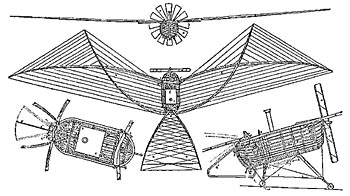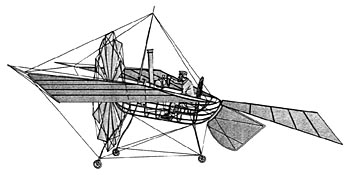
Félix Du Temple de la Croix (1823-1890)
 Félix Du Temple de la Croix Monoplane design of 1857 Download a 750pixel image
The Félix Du Temple Monoplane design of 1857 had a 55ft wingspan and was 24ft long. It was powered by a "hot air" engine. In 1874, with a French sailor as a pilot, the plane was sent down a hill side and succeeded in making a short "hop."
 Félix Du Temple de la Croix Monoplane of 1874 Download a 1000pixel image http://invention.psychology.msstate.edu
The model managed to fly and to land. However, his attempts to achieve the same results with a full-scale plane were unsuccessful until 1874, because of the lack of an adequate propulsion system. In 1874, at Brest in Brittany, France, he successfully launched a bat-like plane with a steam engine carrying a sailor on board. Rising a few feet off the ground, it was the first launch of a manned, powered fixed-wing aircraft. However, the launch took place down a slope and was not pursued. http://www.centennialofflight.gov
Further Reading
Progress in Flying Machines The next apparatus to be noticed was thoroughly experimented with, and years were spent in the endeavor to put it into practical operation. It was first patented by M. Félix Du Temple, a French naval officer, in 1857 and is shown in fig. 41; the top figure representing an end view from the rear and the lower figure being a top view. It consisted in two fixed wings of silk fabric, stretched by curved spars of wood or metal, and firmly attached to a car containing the motor. In front of this a screw was attached with a pivoted axle, in order to draw the apparatus forward. An horizontal tail hinged at the car was to regulate the angle of incidence and of flight of the machine, while a vertical rudder under the tail and separate from it was to steer to the right or left. The car was to be shaped like a boat, lightly constructed of wood or iron ribs, and might be covered on the outside with tarred or rubber cloth. Beneath it were to be hinged three hollow legs, which might either be folded up or allowed to hang down. Strong springs inside of them were to carry rods or feet, at the outer end of which were to be wheels to roll over the ground. These legs were to be so adjusted in length that the apparatus should present an angle of incidence of about 20 to the horizon, and upon being put into forward motion, at the rate of about 20 miles per hour, by the screw, it was expected to rise upon the air and to enter upon its flight, the latter being regulated by the horizontal tail and by the vertical rudder. The motor might be steam, electricity, or some other prime mover, and it was estimated that 6 H.P. would be required for en apparatus; weighing one ton. This was a very great underestimate, for the proposed plan of driving the machine over the ground by means of the aerial screw would largely increase the resistance, and sufficient speed could not be obtained to rise upon the air. M. Du Temple tried many experiments with models shaped like birds, and his patent indicates that he had carefully considered the question of stability, for he places the preponderance of weight toward the front of the car, provides for a diedral angle during flight by the flexibility and shape of the wings, and produces a slight turning up of the rear edge by making it flexible, all much as in the paper aeroplane which has been described. There was a weak point, however, in the fact that the center of gravity was not adjustable during flight so as to correspond with the change in the center of pressure, produced by such alterations in the angle of incidence as might result from the action of the tail or otherwise. When he began with the aid of his brother, M. Louis du Temple, to experiment on a large scale, the inadequacy of all motors then known became apparent. They first tried steam at very high pressures, then a hot-air engine, and finally built and patented, in 1876 a very light steam boiler weighing from 39 to 44 Ibs. to the horse power, which appears to have been the prototype of some of the light boilers which have since been constructed. It consisted in a series of very thin tubes less than 1/8 in. in internal diameter, through which water circulated very rapidly, and was flashed into steam by the surrounding flame. This is understood to have been applied to a slightly modified form of the main apparatus, built in 1874 at Brest by M. Du Temple. This was calculated to carry a man, was 40 ft. across from tip to tip, weighed about 160 Ibs., and cost upward of $6,000, the workmanship being very fine. Careful search by the writer through various French and English publications has failed to discover any account of the operation of this machine, save the statement of M. Tissandier that "not withstanding most persevering efforts, no practical results could be obtained in experimenting with this apparatus."
|
© Copyright 1999-2002 CTIE - All Rights Reserved - Caution |